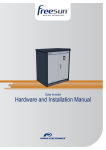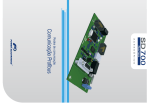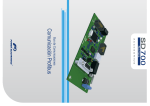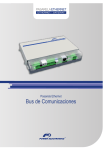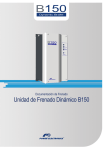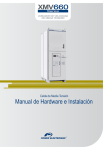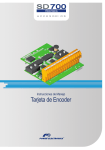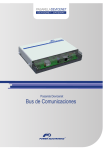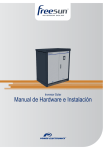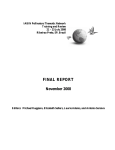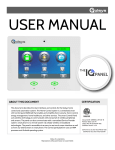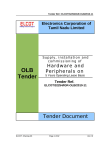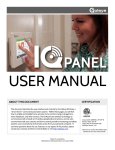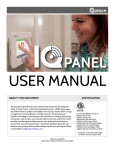Download Service Manual - Power Electronics
Transcript
Solar Inverter Service Manual Solar Inverter – LVT Service Manual Edition: October 2012 FSMS04AI Rev. A FREESUN 2 POWER ELECTRONICS POWER ELECTRONICS FREESUN SAFETY SYMBOLS Always follow safety instructions to prevent accidents and potential hazards from occurring. WARNING CAUTION This symbol means improper operation may results in serious personal injury or death. Identifies shock hazards under certain conditions. Particular attention should be given because dangerous voltage may be present. Maintenance operation should be done by qualified personnel Identifies potential hazards under certain conditions. Read the message and follow the instructions carefully. E N G L I S H Identifies shock hazards under certain conditions. Particular attention should be given because dangerous voltage may be present. Edition of October 2012 This publication could present technical imprecision or misprints. The information here included will be periodically modified and updated, and all those modifications will be incorporated in later editions. To consult the most updated information of this product you might access through our website www.power-electronics.com where the latest version of this manual can be downloaded. SAFETY SYMBOLS 3 FREESUN POWER ELECTRONICS Revisions Date Revision Description 10 / 10 / 2012 A First Edition The equipment and technical documentation are periodically updated. Power Electronics reserves the right to modify all or part of the contents of this manual without previous notice. 4 POWER ELECTRONICS FREESUN INDEX SAFETY INSTRUCTIONS ........................................................................................................... 6 1. INTRODUCTION .................................................................................................................. 1.1. Maintenance Task in Freesun Inverter ......................................................................... 1.2. Maintenance Task in Freesun String Supervisor.......................................................... 10 11 12 2. MAINTENANCE OF THE FREESUN ................................................................................... 2.1. Topology ...................................................................................................................... 2.2. Reading out Historical Data and Errors ........................................................................ 2.3. Cleaning the Electronic Parts ....................................................................................... 2.4. Protective Grids at the Air Inlets and Outlets................................................................ 2.5. Checking the Power Cable Connections ...................................................................... 2.6. Checking the Fans ....................................................................................................... 2.7. Checking the Heating and the Hygrostat ...................................................................... 2.8. Checking Protective Devices........................................................................................ 13 13 13 13 14 14 15 15 16 MAINTENANCE OF THE FREESUN STRING SUPERVISOR ............................................ 20 3. INDEX E N G L I S H 5 FREESUN POWER ELECTRONICS SAFETY INSTRUCTIONS IMPORTANT! Read this manual carefully to maximise the performance of this product and to ensure its safe use. In order to use appropriately the FREESUN, please, follow all instructions described in the installation manual referred to transport, installation, electrical connection, and commissioning of the equipment. Power Electronics accepts no responsibility or liability for any and all damage resulting from inappropriate use of the equipment. The information contained in the installation guide must be observed when installing the inverter. PRIOR TO CONNECTION In the rear side of the solar inverter are located the SECURITY FIXATIONS FOR TRANSPORT in both the transformer and the inductance of the inverter. Before making any connections to the inverter is necessary to consider: If the inverters are going to be installed side by side, it is NECESSARY to REMOVE these SECURITY FIXATIONS BEFORE placing them in their final location. It is ESSENTIAL to REMOVE them BEFORE CONNECTING. Make sure that all fixations are properly removed and put back the rear covers of the inverter. The inverter can now be placed in its final location and the connection procedure can be done as described in the installation manual attached to the inverter. WARNINGS AND RECOMMENDATIONS If your device has the positive or negative pole of the photovoltaic system earth connected, the following instructions must be considered: The only point in the installation where the positive or the negative pole should be grounded is in the proper inverter (through the 4-pole circuit breaker that is added to that effect). It is important to note that if there was another grounded connection elsewhere in the installation (in the panels themselves, in the String Supervisor, etc..) the protection provided by the additional circuit breaker would have NO effect. Therefore, it is recommended to revise periodically the insulation between the pole that is going to be grounded and the earth. Like this, it will be possible to detect a ground fault unwanted in other points of the installation. This will prevent the circuit breaker from providing inappropriate protection due to eventual uncontrolled ground leakages. 6 SAFETY INSTRUCTIONS POWER ELECTRONICS FREESUN In this manual, safety messages are classified as follows: WARNING If possible do not remove the solar inverter cover while the power is applied or the unit is in operation. Otherwise electric shock could occur. If possible do not run the solar inverter with any of the covers removed. Otherwise you may get an electric shock due to the high voltage terminals inside the inverter. E N G L I S H Do not open the inverter doors except when necessary for installation or maintenance, even in such cases, remove the input power if possible. Otherwise you may access the charged circuits and get an electric shock. Operate the switches with dry hands. Otherwise you may get an electric shock. Do not use cables with damaged insulation. Otherwise you may get an electric shock. Do not subject the cables to abrasions, excessive stress, heavy loads or pinching. Otherwise, you may get an electric shock. CAUTION Install the inverter on a non-flammable surface. Do not place flammable material nearby. Otherwise fire could occur. Disconnect the input power if the solar inverter gets damaged. Otherwise it could result in a secondary accident or fire. After the input power is applied or removed, the inverter will remain hot for a couple of minutes. Touching hot parts may result in skin burns. Do not apply power to a damaged inverter or to an inverter with parts missing even if the installation is complete. Otherwise you may get an electric shock. Do not allow lint, paper, wood chips, dust, metallic chips or other foreign matter into the inverter. Otherwise fire or accident could occur. SAFETY INSTRUCTIONS 7 FREESUN POWER ELECTRONICS WARNINGS RECEPTION The Freesun is carefully tested and perfectly packed before leaving the factory. In the even of transport damage, please ensure that you notify the transport agency and POWER ELECTRONICS: 902 40 20 70 (International +34 96 136 65 57) or your nearest agent, within 24hrs from receipt of the goods. UNPACKING Make sure model and serial number of the solar inverter are the same on the box, delivery note and unit. Each solar inverter is supplied with a technical manual. RECYCLING Packing of the equipments should be recycled. For this, it is necessary to separate different materials included (plastic, paper, cardboard, wood, ...) and deposit them on proper banks. Waste products of electric and electronic devices should be selectively collected for their correct environmental management. SAFETY Before operating the solar inverter, read this manual thoroughly to gain and understanding of the unit. If any doubt exists then please contact POWER ELECTRONICS, (902 40 20 70 / +34 96 136 65 57) or your nearest agent. Wear safety glasses when operating the inverter with power applied and the front cover is removed. Handle the solar inverter with care according to its weight. Install the inverter according to the instructions within this manual. Do not place heavy objects on the inverter. Ensure that the mounting orientation is correct. Do not drop the inverter or subject it to impact. The Freesun inverters contain static sensitive printed circuits boards. Use static safety procedures when handling these boards. Avoid installing the inverter in conditions that differ from those described in the Technical Characteristics section. TRIAL RUN 8 Verify all parameters before operating the inverter. Always apply voltage and current signals to each terminal that are within levels indicated within this manual. Otherwise, damage to the inverter may result. SAFETY INSTRUCTIONS POWER ELECTRONICS FREESUN OPERATION PRECAUTIONS Do not modify or alter anything within the inverter. Before programming or operating the Freesun Series, initialise all parameters back to factory default values. WHO'S ABLE TO APPLY THE FOLLOWING INSTRUCTIONS? Only trained electricians approved by the responsible energy supply company may install and commission the inverters. The instructions assume that you, the installer, are familiar with electrical installations and know the corresponding rules and regulations. E N G L I S H SPECIAL HAZARDS OF PHOTOVOLTAIC SYSTEMS Photovoltaic systems have special characteristics that can represent special hazards: An active power source is connected. This means that, regardless to the operating mode of the inverter, there may be voltage present, either from the photovoltaic generator and/or the FREESUN. This is especially important to consider when disconnecting particular parts of the system. Very high DC voltages are present (no zero-crossing) which, in case of a fault or inappropriate use of fuses or plugs, may lead to arcing. The short-circuit current of the photovoltaic generator is only slightly more than the maximum operating current and is also dependent on the level of a solar irradiation. This means that, if a short circuit occurs in the system, the existing circuit breakers are not guaranteed to switch off. A highly branched generator array may be difficult to disconnect if a fault develops (e. g. short circuit). We recommend the extra use of external DC circuit breakers for disconnecting the inverter and/or the DC main cables / String supervisors (DC circuit breakers are built-in). One circuit breaker should be allocated to each input, and these should be located near to de FREESUN as described in the standard VDE0100 part 7-712 and the VDI 6012 regulations. Power Electronics must be informed of the required AC grid connection type The device contains capacitors on the AC and DC sides. The discharge time of the capacitors is longer than 10 minutes. For this reason, it is required to wait longer than this time before making any operation or maintenance actions in the unit. SAFETY INSTRUCTIONS 9 FREESUN POWER ELECTRONICS 1. INTRODUCTION The Freesun, the string supervisor units and the communication units must be maintained at regular intervals. Maintenance includes the following activities: Inspection of wearing parts, and replacement if necessary Functional test of components Inspection of contact joints Cleaning of cabinet interior, if necessary Ambient conditions The maintenance interval depends on the location and the ambient conditions. A device installed in a dusty environment requires more frequent maintenance than recommended. The maintenance interval is to be adapted accordingly. Figure 1.1 Freesun LVT frame 3 (General view) 10 INTRODUCTION POWER ELECTRONICS FREESUN Maintenance Task in Freesun Inverter MAINTENANCE TASK MAINTENANCE INTERVAL (RECOMMENDED) Reading of historical data and errors Cleaning the protective grids at the air inlets and outlets. Checking of dust, dirt, humidity and water leaks inside the inverter. Clean the Freesun if necessary. Check all power cable connections for looseness and tighten them if necessary. Check the connectors and insulation for discoloration or degradation. If necessary, replace any damaged connectors or corroded contacts. Check the safety notices and stickers on and in the switch cabinet and replace missing or damaged labels. Check all cooling fans for functionality and operating noise. Checking the heating and the hygrostat Checking protective devices: Line circuit breaker Power switch Checking the fuses and disconnectors. Checking the overvoltage arrester. Checking of main AC voltage and auxiliary 230 V and 24 V voltages. Checking of over temperature function. Checking of grounding operation (GFDI) Changing intervals of heating and ventilation parts. 1 month * (depending on inverter size) 12 months [*] 12 months [*] 12 months [*] E N G L I S H 12 months 12 months 12 months 12 months 12 months 12 months [*] 12 months 12 months 12 months 12 months [*] Maintenance interval could be shorter if required by location or ambient conditions. INTRODUCTION 11 FREESUN POWER ELECTRONICS 1.1. Maintenance Task in Freesun String Supervisor MAINTENANCE TASK Check all power and string cable connections for looseness and tighten them if necessary. Check the connectors and insulation for discoloration or degradation. If necessary, replace any damaged connectors or corroded contacts. Check the String Supervisor fixation. Check whether the enclosure is damaged and properly sealed. Make sure that the cover locks are correctly closed. They are closed under light pressure by means of a screwdriver until they lock into position (1/4 turning). Check whether there is condensation water in the device. Check the pressure adjusting screw for dirt or damage and replace it, if necessary. Check the plexiglass covers above the string fuses. Check the safety notices on and in the device and replace them if they are damaged or no longer legible. Visually check the existing fuses and tension springs on the fuse holders. Check the ground connection and the contact resistance to the ground potential. Check the overvoltage protector, the visual display must be green 12 INTRODUCTION MAINTENANCE INTERVAL (RECOMMENDED) 12 months 12 months 12 months 12 months 12 months 12 months 12 months 12 months 12 months 12 months 12 months POWER ELECTRONICS FREESUN 2. MAINTENANCE OF THE FREESUN 2.1. Topology The next figure show an example of the Freesun for frame 3, frame 1 and indoor, outdoor . E N G L I S H Figure 2.1 FREESUN Frame 3 indoor front view Figure 2.2 FREESUN Frame 1 outdoor front view 2.2. Reading out Historical Data and Errors A regular check of the plant operation is necessary to recognize possible failures which have no alarm function. Furthermore, plant operation might be improved by analyzing the plant data. Deviations from the optimum operation can result in yield losses and thus in a reduction of the plant's profitability. Depending on the plant size, the error memory of the inverter as well as the long-term data of the data logger must be analyzed at least once a month. Proceed as described in the Programming and Software Manual. 2.3. Cleaning the Electronics Parts The electronic parts of the Freesun inverters are considerably well-protected and thus require almost no maintenance work. Only carry out a visual inspection and clean the circuit boards with a soft brush or a vacuum cleaner with a soft top part if there are dust deposits. The cleaning equipment must be anti-static and ESD-compliant. Do not use any hard or coarse brushes. Do not use pressurized air. MAINTENANCE OF THE STRING SUPERVISOR 13 FREESUN POWER ELECTRONICS 2.4. Protective Grids at the Air Inlets and Outlets This section describes how to clean the protective grids at the air inlets and outlets. Exchanging the protective grids is only necessary in case of damage. 2.4.1. Freesun Ventilation In order to cool the inverter, the ventilation system must be free of any obstructions to ensure the required inlet ventilation and heat dissipation. The specified minimum clearances must be maintained to ensure the proper ventilation and heat dissipation as described in the previous sections. The permissible ambient temperature in order to ensure the correct operation and maximum feed-in performance is between -20ºC and +50ºC. The exhaust air (waste heat) is blown out through the rear part of the inverter. Figure 2.3 Ventilation for the FREESUN 2.5. Checking the Power Cable Connections 14 1. Check all power cable connections and tighten them if necessary. 2. Check the connectors and insulation for discoloration or degradation. 3. If necessary, replace any damaged connectors or corroded contacts. INTRODUCTION POWER ELECTRONICS FREESUN 2.6. Checking the Fans The device is equipped with several fans for cooling. To perform any work on the fans is recommended that the equipment is switched off. This procedure should be taken into account for commissioning, maintenance and repair work. Check all cooling fans for functionality and operating noise, while the Freesun is stopped and the doors are opened. You can use the test fan mode in order to check the interior Freesun fans. 2.7. Checking the Heating and the Hygrostat Immediately after isolating the device, depending on the operating conditions, certain components can be very hot (e. g. fuses, transformer core, sine wave filter, heatsinks, etc.). Safety gloves should always be worn when working near components that can be expected to be very hot. We recommend that safety gloves be worn during all work on the inverter. E N G L I S H Depending on the version, one or several heating models are installed. 1. Switch the Freesun to "Stop" and open the doors. 2. Ensure that the Freesun is connected to a control voltage (supply voltage). 3. Tape door contact switch to the "On" position. 4. Turn the hygrostat down as far down as possible. If the value is smaller than the current air humidity, the heater is activated. If the air humidity is too low, a functional test of the heater cannot be carried out. In this case, the hygrostat does not switch on, even if it is set to the minimum value. If the hygrostat has been switched through, the heating fans must start and the air blown through the heat sink must heat up. 1. Once the functional test of the heating has been conducted, adjust the hygrostat back to the initial setting. The value is specified with an adhesive label on the thumb wheel and in the circuit diagram. 2. Release door contact switches (remove the adhesive tape). 3. Close the cabinet doors. MAINTENANCE OF THE STRING SUPERVISOR 15 FREESUN POWER ELECTRONICS 2.8. Checking protective devices All work on the FREESUN may only be performed when: 1- The device is safely disconnected from de PV voltage (DC), the grid voltage (AC), and the auxiliary power supply (internal or external), 2- Power sources are secured against being switched on, and the device is voltage-free. Only qualified technical personnel may undertake any such task. Figure 2.4 FREESUN Frame 1 internal view 16 INTRODUCTION Figure 2.5 FREESUN Frame 3 internal view POWER ELECTRONICS FREESUN 2.8.1. Electrical Connections to the AC Grid Power The AC grid connection is made at the TN-C, TN-S, TT grid connection type, which must be provided by the customer, using a 3-phase system equipped for 400V. In addition, it is also necessary to verify that existing rotary field on L1, L2 and L3 is the same than inverter phase sequence; on the contrary a trip will be generated. The grid connection must be installed in a way such that a right-hand rotary field lies at the input of the cabinet. In case of a left-hand rotary field is present, the inverter will generate a trip. Cehck that the grid connection cable is fused at the nominal current indicated on the name plate. If the specified nominal current differs from the nominal current of the fuse plug, the fuse plug having the next highest nominal current may be used. The cables for AC connection will be fixed using M8 cable lugs. E N G L I S H Figure 2.6 View of the base plates for cable routing and the FREESUN electrical connections Figure 2.7 AC connection terminals MAINTENANCE OF THE STRING SUPERVISOR 17 FREESUN POWER ELECTRONICS 2.8.2. PV Generator Power Connection (DC Connection) A busbar that allows string distribution boxes to be connected is located in the left lower area of the inverter sidewall. Cables rated for a minimum of 900V // 1000V are required for connecting the DC cables to the fuse inputs of the inverter. Suitable cable screw connections must be installed in the busbar plates to provide strain relief for the cable. The DC cables are connected directly to the busbar using M10 cable lugs. The DC voltage of the PV generator must never exceed the maximum permissible inverter input voltage. Otherwise the inverter is in acute danger when connected: UPV < 900 // 1000 V. A B Figure 2.8 View of DC connection area with on-load disconnector (A) and circuit breaker (B) 18 INTRODUCTION POWER ELECTRONICS FREESUN 2.8.3. Checking the DC Main Switch Each module in the Freesun inverter has a motor-driven circuit breaker on the DC side. This switch is equipped with a circuit breaker, a springpower storage device, an off key, and a position display. 1. Switch the Freesun to "Stop" and open the doors. 2. Ensure that the Freesun is connected to a control voltage (supply voltage) and is supplied with power. 3. Tape door contact switch to the "On" position. 4. Switch the Freesun to "Start". The DC switch is switched on and shifts to "On" position. E N G L I S H 5. Switch the Freesun to "Stop". The DC switch trips and shifts to "Off" position. 6. Release door contact switches (remove the adhesive tape). 7. Close the cabinet doors. 2.8.4. Checking the Fuses and Disconnectors 1. Visually check the existing fuses and tension springs on the fuse holders. 2. Check all power cable connections for looseness and tighten them if necessary. Check the connectors and insulation for discoloration or degradation. Replace any damaged connectors or corroded contacts. 3. Check all string cable connections for looseness and tighten them if necessary. Check the insulation, and the terminals on the assembly as well on the busbar for discoloration or degradation. If necessary, lubricate the contacts. 2.8.5. Checking the Overvoltage Protector The inverters have several overvoltage protectors which need to be regularly checked for correct function. You can locate the exact position and number of overvoltage protectors using the reference designation of the components in the provided circuit diagram (Installation Manual). The overvoltage protectors are inspected visually and by means of measurements. 1. Visual inspection of the arrestor for optical signs of wear. 2. Check the operating readiness of the protector via the function and fault signaling (A) of the protection path which is free of operating current. Visual display green Visual display red Overvoltage protector is ready for operation Overvoltage protector defective 2.8.6. Maintaining the Insulator Monitor The GFDI is subject to aging caused by wear of the contacts every time they are tripped. Due to aging, sensitivity is reduced. Check the insulation of the PV generator in regular maintenance intervals in order to ensure the functionality of the insulator monitor. 1. Visual inspection of the insulator monitor. Remove possible dirt or dust deposits by using a vacuum cleaner or with compressed air. 2. Pulse test mode in order to verify the correct performance of the insulator monitor. The plant operator determines the insulation test of the entire plant. In case the mechanical or optical check is not fulfilled or in accordance with the maintenance protocol, the insulator monitor must be replaced. Replacement is also necessary after at least after 100 ground faults which led to the tripping of the insulator monitor. Maintenance work of the soft grounding is carried out after checking the insulator monitor. Once tripped, manually reset the failure via the button. MAINTENANCE OF THE STRING SUPERVISOR 19 FREESUN POWER ELECTRONICS 3. MAINTENANCE OF THE FREESUN STRING SUPERVISOR The environmental conditions that should be considered for the correct installation and operation of the string supervisor are: o TEMPERATURE RANGE -20ºC to +50ºC o RELATIVE HUMIDITY 15 to 95% o ALTITUDE 1000m over sea level o POLLUTION DEGREE Type II The String Supervisors are usually installed near the modules at the open air. Depending on the system size, an increased number of String Supervisors is required which must be taken into account during maintenance work. In the following, some steps are listed which serve as maintenance instruction. Figure 3.1 String Supervisor external view First, check the installation site for accessibility, inflammable materials and safe positioning and then make sure that the String Supervisor is attached to a horizontal installation and that a sufficient sun shading system is available. Figure 4.2 String Supervisor internal view 20 INTRODUCTION POWER ELECTRONICS FREESUN 1. Check whether the enclosure is damaged and properly sealed. 2. Make sure that the lid is securely in place and properly sealed. Make sure that the cover locks are correctly closed; they are closed under light pressure by means of a screwdriver until they lock into position (1/4 turning). 3. Check whether there is condensation water in the device. Wipe out the String Supervisor, check from where the water intruded the device and take corrective measures. 4. Check the pressure adjusting screw for dirt or damage and replace it, if necessary. 5. Check the Plexiglass covers above the string fuses. 6. Check the safety notices on and in the device and replace them if they are damaged or no longer legible. You can order new labels from Power Electronics. 7. Visually check the existing fuses and tension springs on the fuse holders. 8. In addition, check the auxiliary voltage of +24 V at the connection terminals and the plug connectors; it must be at least +21 V. 9. Check all power cable connections for looseness and tighten them if necessary. Check the connectors and insulation for discoloration or degradation. Replace any damaged connectors or corroded contacts. 10. Check all string cable connections for looseness and tighten them if necessary. Check the insulation, and the terminals on the assembly as well on the busbar for discoloration or degradation. 11. Check all cable connections of the optional DC main switch for looseness and tighten them if necessary. Check the insulation and the switch for discoloration or degradation. 12. Check the shield connection of the communication link. It must be hand-tightened; therefore, a screwdriver is not suitable. 13. Check the ground connection and the contact resistance to the ground potential. 14. Check the overvoltage protector, the visual display must be green. Maintenance of the String Supervisor is completed. MAINTENANCE OF THE STRING SUPERVISOR E N G L I S H 21 www.powerelectronics.es | www.power-electronics.com 24 Hours Technical Assistance 365 days a year +34 96 136 65 57 HEADQUARTER • VALENCIA • SPAIN C/ Leonardo da Vinci, 24 – 26 • Parque Tecnológico • 46980 – PATERNA • VALENCIA • ESPAÑA Tel. 902 40 20 70 • Tel. (+34) 96 136 65 57 • Fax (+34) 96 131 82 01 BRANCHES BARCELONA • Avda. de la Ferrería, 86-88 • 08110 • MONTCADA I REIXAC Tel. (+34) 96 136 65 57 • Fax (+34) 93 564 47 52 CATALONIA LLEIDA • C/ Terrasa, 13 · Bajo • 25005 • LLEIDA Tel. (+34) 97 372 59 52 • Fax (+34) 97 372 59 52 CANARY LAS PALMAS • C/ Juan de la Cierva, 4 • 35200 • TELDE ISLANDS Tel. (+34) 928 68 26 47 • Fax (+34) 928 68 26 47 VALENCIA • Leonardo da Vinci, 24-26 • Parque tecnológico ● 46980 ● PATERNA Tel. (+34) 96 136 65 57 • Fax (+34) 96 131 82 01 CASTELLÓN • C/ Juan Bautista Poeta • 2º Piso · Puerta 4 • 12006 • CASTELLÓN LEVANT NORTH CENTRE SOUTH GERMANY AUSTRALIA BRAZIL Tel. (+34) 96 136 65 57 MURCIA • Pol. Residencial Santa Ana • Avda. Venecia, 17 • 30319 • CARTAGENA Tel. (+34) 96 853 51 94 • Fax (+34) 96 812 66 23 VIZCAYA • Parque de Actividades • Empresariales Asuarán • Edificio Asúa, 1º B • Ctra. Bilbao · Plencia • 48950 • ERANDIO • Tel. (+34) 96 136 65 57 • Fax (+34) 94 431 79 08 MADRID • Avda. Rey Juan Carlos I, 98, 4º C • 28916 • LEGANÉS Tel. (+34) 96 136 65 57 • Fax (+34) 91 687 53 84 SEVILLA • C/Arquitectura, Bloque 6 • Planta 5ª • Módulo 2 • Parque Empresarial Nuevo Torneo • 41015 • SEVILLA Tel. (+34) 95 451 57 73 • Fax (+34) 95 451 57 73 INTERNATIONAL SUBSIDIARIES Power Electronics Deutschland GmbH • Dieselstrasse, 77 • D·90441 • NÜRNBERG ● GERMANY Tel. (+49) 911 99 43 99 0 • Fax (+49) 911 99 43 99 8 Power Electronics Australia Pty Ltd • U6, 30-34 Octal St, Yatala, • BRISBANE, QUEENSLAND 4207 • P.O. Box 6022, Yatala DC, Yatala Qld 4207 • AUSTRALIA Tel. (+61) 7 3386 1993 • Fax (+61) 7 3386 1993 Power Electronics Brazil Ltda • Av. Imperatriz Leopoldina, 263 – conjunto 25 • CEP 09770-271 • SÃO BERNARDO DO CAMPO - SP • BRASIL • Tel. (+55) 11 5891 9612 • Tel. (+55) 11 5891 9762 Power Electronics Chile Ltda • Los Productores # 4439 – Huechuraba • SANTIAGO • CHILE Tel. (+56) (2) 244 0308 · 0327 · 0335 • Fax (+56) (2) 244 0395 CHILE Oficina Petronila # 246, Casa 19 • ANTOFAGASTA • CHILE Tel. (+56) (55) 793 965 CHINA KOREA INDIA ITALY MEXICO NEW ZEALAND UNITED KINGDOM SOUTH AFRICA Power Electronics Beijing • Room 606, Yiheng Building • No 28 East Road, Beisanhuan • 100013, Chaoyang District • BEIJING • R.P. CHINA Tel. (+86 10) 6437 9197 • Fax (+86 10) 6437 9181 Power Electronics Asia Ltd • 20/F Winbase Centre • 208 Queen’s Road Central • HONG KONG • R.P. CHINA Power Electronics Asia HQ Co • Room #305, SK Hub Primo Building • 953-1, Dokok-dong, Gangnam-gu • 135-270 • SEOUL • KOREA Tel. (+82) 2 3462 4656 • Fax (+82) 2 3462 4657 Power Electronics India • No 25/4, Palaami Center, • New Natham Road (Near Ramakrishna Mutt),• 625014 • MADURAI Tel. (+91) 452 452 2125• Fax (+91) 452 452 2125 Power Electronics Italia Srl • Piazzale Cadorna, 6 • 20123 • MILANO • ITALIA Tel. (+39) 347 39 74 792 P.E. Internacional Mexico S de RL • Calle Cerrada de José Vasconcelos, No 9 • Colonia Tlalnepantla Centro • Tlalnepantla de Baz • CP 54000 • ESTADO DE MEXICO Tel. (+52) 55 5390 8818 • Tel. (+52) 55 5390 8363 • Tel. (+52) 55 5390 8195 Power Electronics New Zealand Ltd • 12A Opawa Road, Waltham • CHRISTCHURCH 8023 • P.O. Box 1269 CHRISTCHURCH 8140 Tel. (+64 3) 379 98 26 • Fax.(+64 3) 379 98 27 Power Electronics UK Pty Ltd• Wells House, 80 Upper Street, Islington, • London, N1 0NU • 147080 Islington 5 Tel. (+34) 96 136 65 57 • Fax (+34) 96 131 82 01 Power Electronics South Africa Pty Ltd • Central Office Park Unit 5 • 257 Jean Avenue • Centurion 0157 Tel. (+34) 96 136 65 57 • Fax (+34) 96 131 82 01 www.power-electronics.com


























